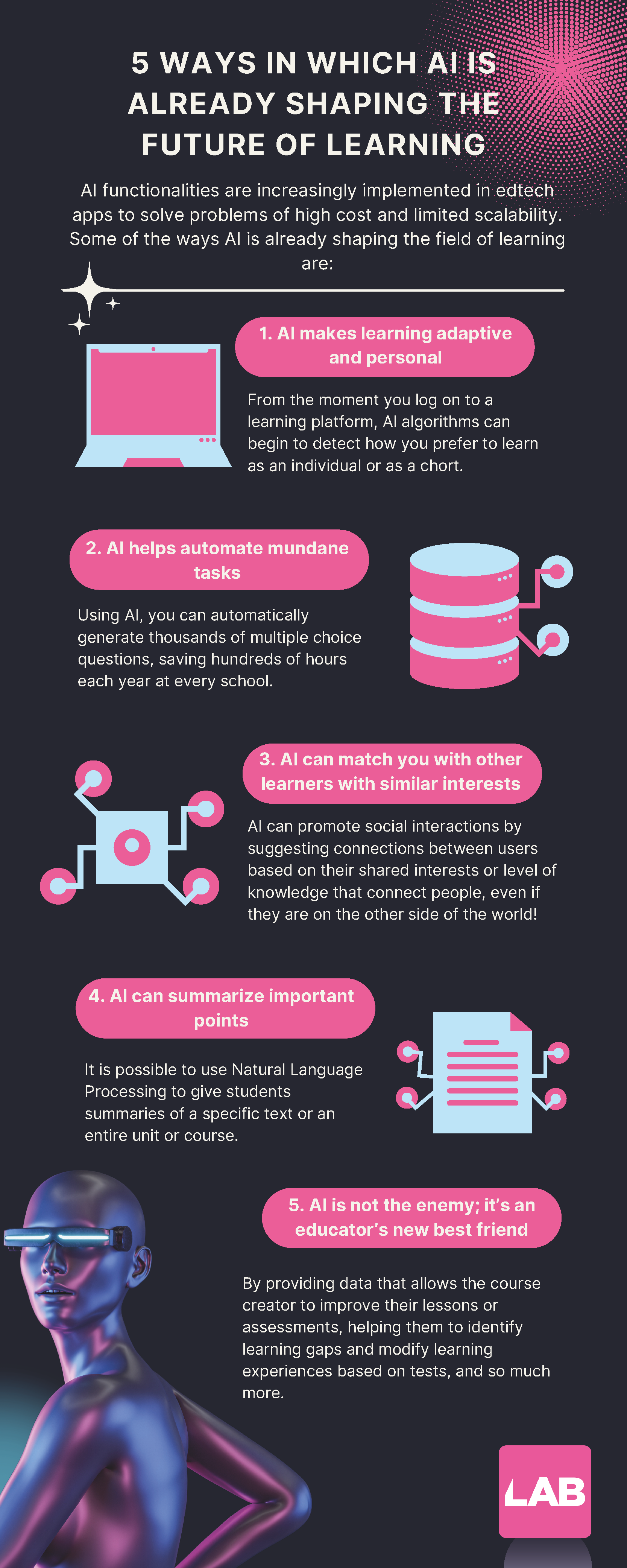- Where was this product built?
- What biases may influence the learning that is facilitated on the platform, and
- Where is the data stored?
The discussion of the use of AI in learning and the mainstream exploration of software bias and embedded learning approach in software is a fairly new discussion in learning. Even though the pandemic brought an increase in the adoption of new technologies, software, and Learning Experience Platforms (LXPs), many companies and educational institutions still use learning systems that promote a one-size fits all approach.
AI, Machine Learning (ML), and Natural Language Processing (NLP), are technologies used across industries that are revolutionizing how we do things by reducing the time we have to put into different tasks (automation) and bringing a higher level of accuracy and efficacy to different fields like medicine, finance, and education.
AI, Machine Learning (ML), and Natural Language Processing (NLP), are technologies used across industries that are revolutionizing how we do things by reducing the time we have to put into different tasks (automation) and bringing a higher level of accuracy and efficacy to different fields like medicine, finance, and education. Whether you are implementing learning in a school or at a company, it’s time to fully leverage what the new technologies have to offer. To get you up to speed on some of the newest trends, we have compiled a list of 5 ways AI is already shaping the future of learning.
5 Ways in which AI is already Shaping the Future of Learning
AI functionalities are increasingly implemented in edtech apps to solve problems of high cost and limited scalability. It’s no secret that implementing a new LXP can be a long and demanding process, but many companies are chasing that using AI: They are automating several monotonous tasks, increasing efficiency and productivity, and personalizing the learning offering to the end user. Some of the ways AI is already shaping the field of learning are:
1. AI makes learning adaptive and personal
From the moment you log on to a learning platform, AI algorithms can begin to detect how you prefer to learn as an individual or as a chort. Should the teacher/learning designers promote more quizzes or learning journals? No need to guess, today they can consult real-time data. The next frontier in adaptive learning is creating entire learning journeys or flows that adjust to each learner based on their interests, learning preferences, needs, skills, and what they wish to learn.
2. AI helps automate mundane tasks
There is a reason most teachers aren’t singing hallelujah when we talk about adaptive learning. That’s because it requires a lot of extra work to enable. But, using AI, you can automatically generate thousands of multiple choice questions, saving hundreds of hours each year at every school. If you are curious about how this works, you can read more about how we created an AI quiz engine here.
3. AI can match you with other learners with similar interests
There is no question about it: We learn better when we learn with others and socialize with our peers, which is probably the most significant advantage of face-to-face learning. However, fear not, for the right algorithms and tools online can promote social interactions by suggesting connections between users based on their shared interests or level of knowledge and fostering conversations and exercises that connect people, even if they are on the other side of the world!
4. AI can summarize important points
What are the key takeaways from a specific text? What are the most essential points of a unit? Can the students define vital concepts needed to move on to the next unit? Today, it is possible to use Natural Language Processing to give students summaries of a specific text or an entire unit or course. The way we consume data, news, and learning content is constantly changing. We “snack” more, have a shorter attention span, and rely more on video. As a response, many news sites now summarize critical findings in their articles at the top, either for those who want a bit more than the headline or for people to choose whether they want to invest the time in reading the entire article. This approach can be applied in learning using AI.
5. AI is not the enemy; it’s an educator’s new best friend
AI can become an educator’s new best friend by providing data that allows the course creator to improve their lessons or assessments, helping them to identify learning gaps and modify learning experiences based on tests to review what is missing and ensure that understanding is complete and creating reports to help improve learning experiences, by detecting patterns in learners and suggesting teachers different actions to improve the learning experience.
In CanopyLAB, we are already two steps ahead, bringing you the future of education today by combining the best aspects of F2F learning with the magic and potential of technology.
In CanopyLAB, we are already two steps ahead, bringing you the future of education today by combining the best aspects of F2F learning with the magic and potential of technology. Indeed, our platform was based on a social media interface because we wanted to ensure that learners would continue to socialize and learn from each other. Plus, we kept course creators in mind by creating the first AI Course Authoring Tool, AICATO, which reduces the time educators spend creating courses and helps them build truly personalized learning experiences.
We have barely scratched the surface when it comes to AI in education, but as you see, much like tools like Siri or Alexa have made our lives easier in many different ways, AI has a great potential to improve the way we learn and teach. Moreover, allowing educators to create personalized learning experiences and spend more time with students can revolutionize the entire education system by ensuring that each learner has the opportunity to reach their full potential and develop the 21st-century skills needed to succeed in the job market.




